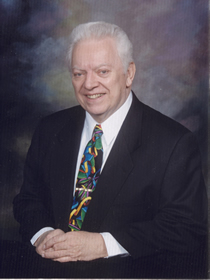
In recognition of his outstanding accomplishments in the field of computer science and engineering, his dedication working with students and faculty from almost every discipline of the university, his efforts to continuously improve computing infrastructure, his work to advance understanding of computational algorithms of high importance and complexity, and his entrepreneurial spirit as co-founder of the Institute for Computational Science, Co-Director of Center for Communication and Information, Director of Research Computing Group, founder of i2rd, and inspiration of many other spin-offs, the School of Computing of the University of Nebraska–Lincoln proudly inducts Dr. Don J. Nelson into the Nebraska Hall of Computing.
Don J. Nelson was born on a farm near Pilger, Nebraska, on August 17, 1930. He attended District #50, a one-room country school house, through eighth grade and graduated from Pilger High School in 1948. He attended the University of Nebraska and received his Bachelor's degree in Electrical Engineering. He served as a member of the Technical Staff at Bell Labs in New York City and then entered active duty as a second lieutenant in the U.S. Air Force.
During his military service, Nelson taught delivery of special weapons (atomic). He also designed and developed a trainer and textbook for pilots attending flight school at Sandia Air Force Base. He returned to the University of Nebraska and received his Master's degree in Electrical Engineering. He received his Ph.D. in Electrical Engineering at Stanford University and returned to Nebraska, retiring in 2005 after 50 years at Nebraska.
As a graduate student, Nelson built the first Electronic Analog Computer (UNEBAC) for the University of Nebraska. He was subsequently asked to serve as Director of the University of Nebraska–Lincoln Computing Center, which eventually grew to employ over 100 experts in computational science and served as the university's center for hardware and software support in the early days of computer usage. Development of the university's computational core required financing to hire the best and brightest analysts and computer programmers.
Nelson and his staff at the Computing Center put the Nebraska State Laws online into machine-readable form and designed and supervised the development of a Law Information Retrieval Program for the College of Law. Later, Nelson designed and supervised the development of the Bill Drafting System for the Nebraska State Legislature.
Faculty from every discipline looked to the Computing Center staff for assistance in development and programming for their research projects. Funding for services from both inside and outside the university secured the Center's growth and facilitated its rise to prominence when computer expertise was scarce among universities nationwide.
Nelson developed a Remote Job Entry System (NUROS) that allowed students and faculty researchers to obtain online access from their labs and offices. These NUROS terminals were able to communicate with the Computing Center and have computational access and services, whether from the Press Box at Memorial Stadium or from London, England.
During the rapid growth of the computer age, Nelson co-founded the Institute for Computational Sciences, which later became the Department of Computer Science. After he left the University of Nebraska–Lincoln Computing Center and the Institute, he continued his work using computer programming to find solutions. Committed to helping Nebraska industry, Nelson developed a simulation of the operation of the NPPD nuclear plant at Brownville, Nebraska, which allowed the safest and most optimum use of their nuclear resources.
Nelson also designed and developed a simulation program for the U.S. Army, the Mobile Systems Equipment program, which simulated battlefield operations. The system was later employed during Desert Storm and performed "in an exceptional manner" according to military sources.
Nelson continued to teach undergraduate and graduate courses while pursuing his research interests in computer simulation and database management. He had additional contracts with LT&T, Square D Company, Talent +, ACTON, Transcrypt, Nebraska Department of Education, Western Nebraska Community College, Lincoln Public Schools, and several departments and colleges at the University of Nebraska.
He served as Co-director of the Center for Communication and Information Science (Engineering Research Centers) and also as Director of the Research Computing Group. Later, he organized the structure and financing to create a private company, i2rd, which operates in Lincoln and provides software solutions to unique business software development problems.
Nelson devoted his academic and research career of 50 years to helping the students at the University of Nebraska, Nebraska industry, and the people of the State of Nebraska.